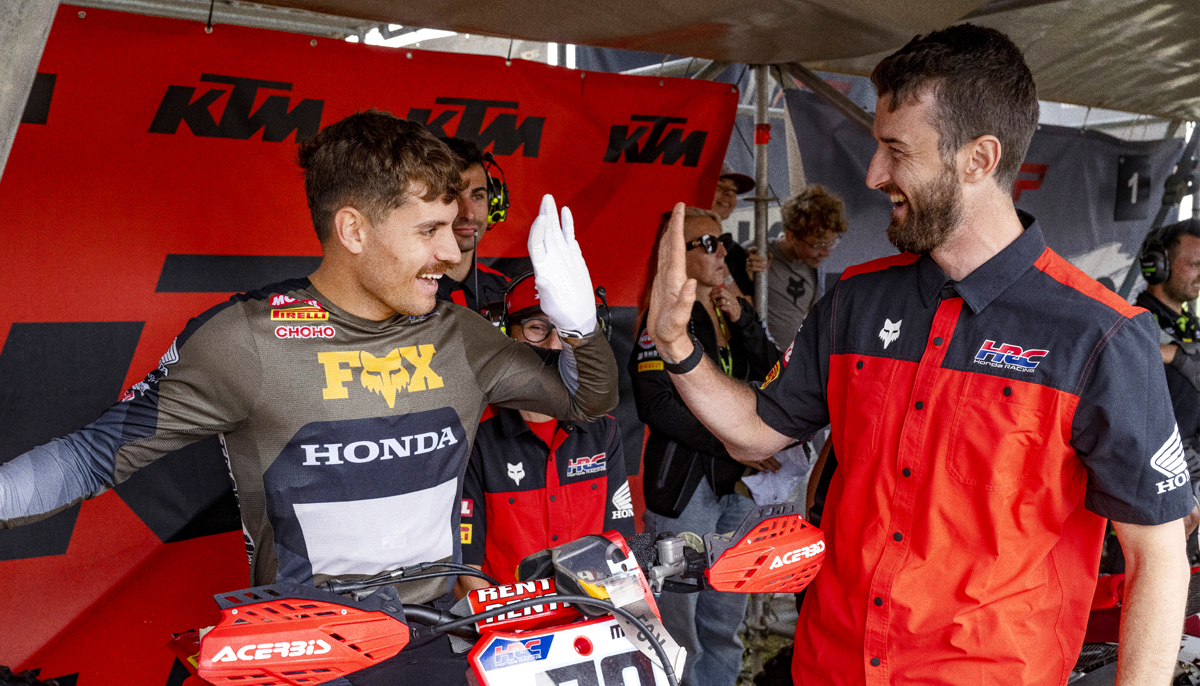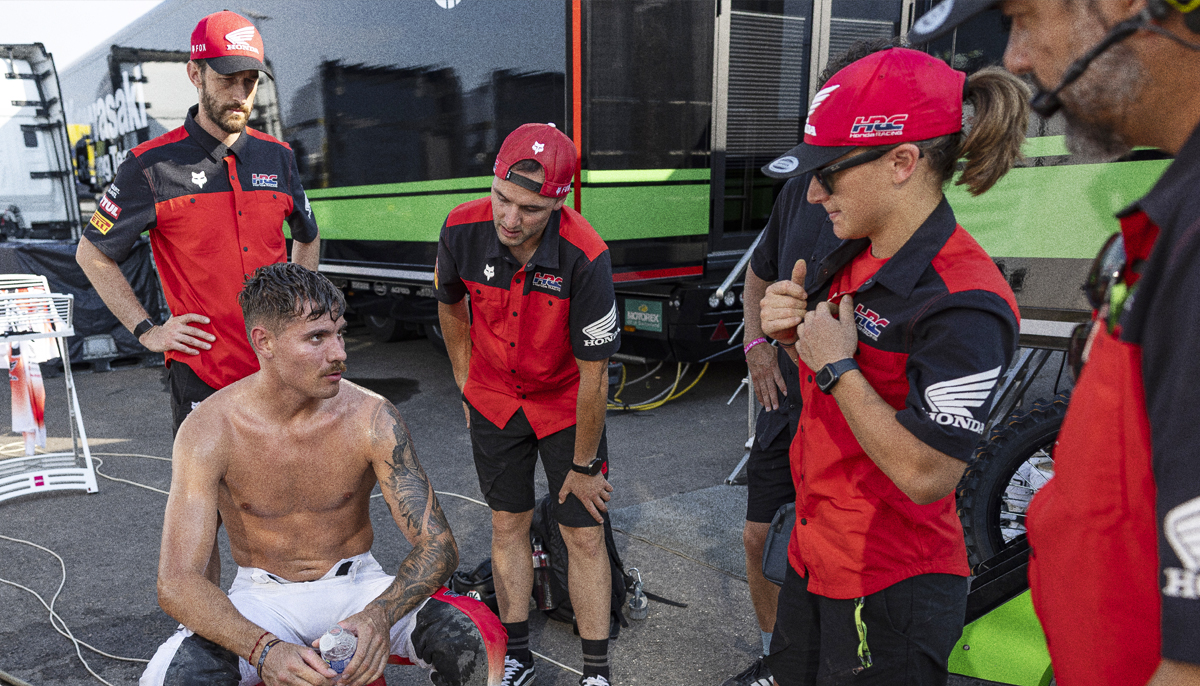
Oscar & Juan Gálvez Racetrack


[ Photo courtesy of Honda HRC ]
The relentlessness and the intensity of supercross means riders are straining muscles, ligaments, heartrate, concentration and the limits of their physical capabilities. Somebody must help keep ‘the other machine’ in check.
Almost any form of motorcycle racing looks tough but dirtbike competition will work muscles that many people don’t realise they have. Supercross is a lung-buster that also requires explosiveness and precision. It’s a hardy mix that oushes the mind and the muscles to the edge.
Racers not only need the conditioning to deal with the adrenaline flow and a pulse that will surge to figures near VO2 max but also the strength and reactions for moments when things go wrong. This means manipulating the bike, correcting any errors and maintaining control.
Professional riders at World Supercross level will have a trainer. Somebody that guides their regime away from the motorcycle, looks after their fitness (doing too much or not enough?) and sometimes does the work with them. This same person can also sort nutrition and act as a confidante. Most will have the number of a doctor in their phones. Some will even have a preferred surgeon. A good few will have a sports psychologist. Many will have somebody they can call on as a coach, usually former racers, that can guide on lines and strategy and technique.
And…almost every single rider in the gate will have a physio, or access to somebody that can alleviate the ardours of the job. What punishment are we talking about?
BODYWORK UNDER PRESSURE
“Well, it’s a difficult question! People assume that riders are ‘destroying’ their bodies because of the physical demands or the injuries but the Pros know what they are doing,” explains 37-year-old Filippo Camaschella, a physio who owns and runs the FC Rehab and Wellness centre in Grignasco, northwest of Milan, and who has been the point-of-call for the MXGP factory HRC Honda team for almost a decade.
“If I had to say one area then there is usually a lot of stiffness in the lower back,” he says, in reference to the time riders spend standing on the pegs, sitting and absorbing impact from jump landings and blitzing whoops.
“They also have arm-pump, and this can be linked to fitness but also other things like stress or over-thinking or fear. Normally in the first pre-season races all the riders are struggling with this because it is the first time at competitive speed or they might be nervous or anxious about their set-up or their starts.”
TIME ON A DIME
Camaschella and his staff will work to relive these muscular blockages but the main obstacle they face is time. A World Supercross event schedule does not permit too much remedial sessions, especially to address any strains, sprains or pulls.
“I would say the main job is pre-race and the day before. It’s when we can work ‘360’ on the athlete’s body. Firstly, because of the extra time we have before the event and where we can really focus on the stiffness or issues the rider might have. The goal of the treatment is to put the athlete’s body in the best balance possible. During the meeting we just have to react where we can.”
Physios are not magicians, but they are experts at putting their clients at ease. This can be through treatments like massage and manipulation and even more advanced methods like like Tecartherapy – a form of deep-tissue stimulation using a device such as the Humantecar machine.
“I was one of the first in the MXGP paddock with some electronic devices,” the Italian says. “Like the team and the bikes, we also need the technology, and to work in a different way and always at the top level. We use this Tecar hardware at the end of some sessions and before the race to stimulate the blood, the circulation and the metabolism.
“We can move the blood and increase the oxygen flow,” he adds. “It also works for the inflammation and for muscle contraction; we improve the circulation, the temperature and the relaxation of the muscle. It is a simple device…but it has a lot of possibilities!”

NO CRASH-TEST DUMMY
There are many ways to crash a motorcycle. Therefore, there are many different types of injuries and permutations. Every rider’s body will react and recover in an alternative way.
“Crash recovery is totally dependent on where they have the trauma on the body,” Camaschella says. “Some riders are more susceptible to certain injuries. Some will break bones easily, others will struggle with ligaments, especially around the knees.
“Injuries can even happen without a crash, purely because of the impact. The knee is exposed to the most risk, because of how often it makes contact with the ground at speed. Sometimes a knee brace has done its job, other times the leg has been broken.”
FINE INSTRUMENTS
Concussion is a complicated problem and then something as mundane as temporary sickness can leave a rider underpowered for the rapid-fire force of a World Supercross Championship evening.
Racers walk a narrow line to display their best performance. They are as highly tuned as the bikes underneath them and follow a dedicated routine, fashioned through years of trial and error, to get to their current level.
“Riders are very versatile with their preparation,” Camaschella reveals. “Cyclists are extremely fit also, but I would say their programmes are quite similar: eating, training, resting, to be simplistic. Supercross and motocross riders have different approaches. Some like to ride the motorcycle more than others and, from my experience, I have seen some riders training a lot in the gym and others not. Some like cycling but there is a difference between those that do it for an hour and others that go for a 200km loop.
“There is no set rule. It is very personal. These guys will be training an hour before they even go training with the motorcycle. They will be stretching for 30 minutes and raising their heartrate for the main work.”
A World Supercross bike will have been stripped, cleaned, refined and fettled…but also spare a thought for the science and dedication that has gone into the athletes.
From all the motorcycle racing disciplines supercross and motocross is probably the most rider-dependent and that means a special level of devotion to the art.
A 90 Day Season Pass, covering the Buenos Aires City GP, the Canadian GP, the Australian GP, the Swedish GP and the season finale in Cape Town, is available for US$30. Click here to grab your season pass and witness the most competitive FIM World Supercross Championship rider lineup to date.
Please note this service is not available in Pakistan, India, Sri Lanka, Bangladesh, Bhutan, Maldives, Nepal and Afghanistan.